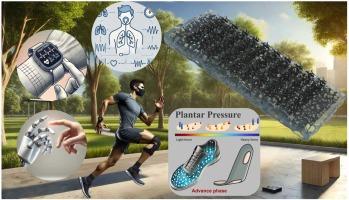Hydrogel-infiltrated micropatterned nano-carbon aerogel sheet composed of partially carbonized cellulose nanofibers for wearable sensor
IF 16.8
1区 材料科学
Q1 CHEMISTRY, PHYSICAL
引用次数: 0
Abstract
It is still a challenge to establish a continuous electronic conductive network for conventional conductive hydrogels served for high-sensitive and comfortably wearable sensors. In this study, a micropatterned hybrid sheet, approximately 1 mm thick, was developed by infiltrating a multifunctional hydrogel precursor within a micropatterned nano-carbon aerogel sheet composed of partially carbonized cellulose nanofibers before gelatinization. The aerogel sheet, designed with parallel rectangular grooves and ridges, has a slightly lower modulus than the hydrogel. The hydrogel, gelatinized within the aerogel sheet in a glycerol-water binary system, features a dual-crosslinked network of bacterial cellulose and a hydrophobically associated copolymer. This design allows the hydrogel to absorb most of the stress during stretching, while the nano-carbon aerogel sheet undergoes controlled crack propagation, leading to uneven deformation and localized stress concentration. This unique stress-handling mechanism imparts the hybrid sheet with a gauge factor (GF) of 12.3ε¹.²⁷ up to 1000 % strain, pressure sensitivity (S) of 31.33p−0.71 in the 0–500 kPa range, humidity sensing capacity and exceptional cycling stability over 1000 cycles under 200 % strain or 50 kPa pressure. The sensor enables precise real-time health monitoring, rehabilitation, disease diagnosis, and human-computer interaction, highlighting the potential of the micropatterned hybrid sheet to advance sensor technology.

求助全文
约1分钟内获得全文
求助全文
来源期刊

Nano Energy
CHEMISTRY, PHYSICAL-NANOSCIENCE & NANOTECHNOLOGY
CiteScore
30.30
自引率
7.40%
发文量
1207
审稿时长
23 days
期刊介绍:
Nano Energy is a multidisciplinary, rapid-publication forum of original peer-reviewed contributions on the science and engineering of nanomaterials and nanodevices used in all forms of energy harvesting, conversion, storage, utilization and policy. Through its mixture of articles, reviews, communications, research news, and information on key developments, Nano Energy provides a comprehensive coverage of this exciting and dynamic field which joins nanoscience and nanotechnology with energy science. The journal is relevant to all those who are interested in nanomaterials solutions to the energy problem.
Nano Energy publishes original experimental and theoretical research on all aspects of energy-related research which utilizes nanomaterials and nanotechnology. Manuscripts of four types are considered: review articles which inform readers of the latest research and advances in energy science; rapid communications which feature exciting research breakthroughs in the field; full-length articles which report comprehensive research developments; and news and opinions which comment on topical issues or express views on the developments in related fields.
 求助内容:
求助内容: 应助结果提醒方式:
应助结果提醒方式:


